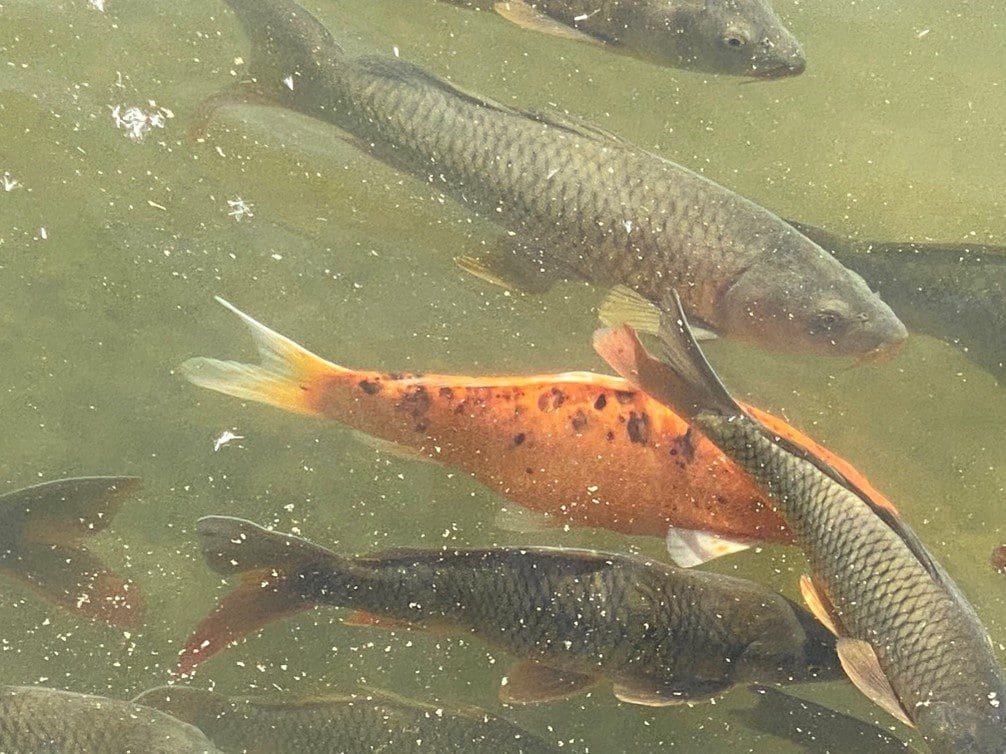The Common Carp

SESAME STREET, ANYONE? WHICH OF THESE FISH IS NOT LIKE THE OTHERS?
If you guessed the golden fish with the black spots, you are correct! That fish is a koi and all the others are common carp (Cyprinus carpio). Koi and carp are close relatives and were deliberately imported to North America. The koi were bred in Japan from an Asian carp subspecies as an ornamental pond fish, and the carp as a potential food source. Both are also closely related to aquarium goldfish, and in fact all of them can interbreed with each other.
Common carp are really common in Clark County Wetlands Park ponds and streams, having made their way upstream into the Park from Lake Mead. They are large, deep-bodied fish with triangular heads. Adults are olive green to gold above, shading to yellow on the belly. Their dorsal and anal fins are armed with stout serrated spines that make them difficult prey for most predators, though other fish, birds like the white pelican, and occasionally mammals feed on them. Each carp has four maxillary “barbels,” (from Middle Latin, “barbula,” meaning “little beard”), two on each side of the mouth. These are sensory organs, covered with the equivalent of taste buds that allow the fish to search for food in murky water, “tasting” the sediment before actually eating anything.
The common carp, also known as the Eurasian or European carp, has a long history as a farmed fish. They are known to have been deliberately raised for food in large, specially built ponds in Roman times, and are recorded as being deliberately introduced by monks to locations in Europe from the thirteenth and sixteenth centuries. Today, common carp are well thought of in Europe and Asia, both as a food and a sport fish. They put up a good fight when hooked, may grow to weights of fifty to seventy pounds, and have long been valued as part of a traditional Christmas dinner in central Europe.
Unfortunately, carp have not proved as popular in the United States. They were extensively stocked across the country between 1878 and 1910, intended for sport fishing and for food. Unfortunately, North American wild carp often do not taste like their Eurasian relatives. In many habitats, carp caught between spring and winter each year have a “muddy” taste caused by a bacteria in the aquatic invertebrates they consume. In addition, American cooks often prefer fish fillets to a whole fish, and carp do not fillet well because of their skeletal structure.
In North America, common carp are found in all of the lower forty-eight states. Around the world, they have been introduced everywhere but the poles! Common carp are often a destructive and invasive species in places where they have been introduced, since they both out-compete many species of native fish and negatively impact aquatic environments.
Carp are widespread in lakes and large rivers. They prefer large bodies of slow or standing water, with soft bottom sediments enriched with plenty of vegetative matter and they tolerate either fresh or slightly brackish water between 37- and 95-degrees Fahrenheit. They are “schooling” fish, and like to live in groups of five or more.
Carp are not picky eaters. They prefer to feed on aquatic invertebrates, including crustaceans, mollusks, and benthic worms, with additions of fish eggs and fish remains. If the nature cafeteria is short of animal food, the carp simply switch to an herbivorous diet of aquatic plants, aquatic tubers, and seeds.
Researchers have observed common carp sucking midge larvae from aquatic plant stems. The fish work from the bottom to the top of the stems, ending at the water’s surface with what has been described as a loud slurp.
I once had a chance to hear that “slurp” firsthand at one of the marinas at Lake Mead National Recreation Area. Visitors to the marina were feeding bags of popcorn to a mixture of fish – mostly Common carp, with some striped bass, and catfish. Popcorn proved very popular, and the fish jostled “shoulder to shoulder,” roiling up the water to grab a share, mouths agape. Sure enough, the dominant sounds heard were splashing and one “slurp” after another!
– By Chris Leavitt, President; photo by Jon Drake
Please enjoy these YouTube videos:
Carp: Fact File (British Wildlife Facets) (Jack Perks Wildlife Media) 2:14
Common carp control (Minnesota Aquatic Invasive Species Research Center) 2:30
Feeding Carp, Catfish and Stripped Bass at Lake Mead in Nevada 2:05
